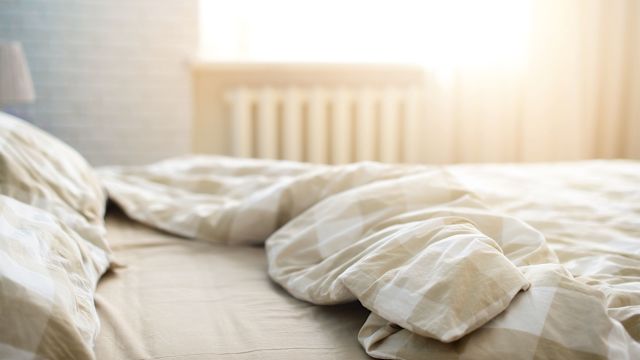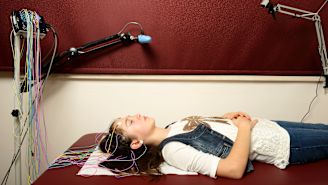Updated on May 5, 2023.
If you’re an adult who’s getting the minimum recommended amount of sleep each night, you’re spending at least 49 hours in your bed each week. That means that a variety of substances—like oil, dirt, sweat, and saliva—are building up on your sheets, even if they look clean. Over time, invisible bedfellows like bacteria and dust mites can also accumulate on your bedding.
These contaminants may not only be unsettling to think about as you crawl into bed. Sleeping on dirty bedding could also have health consequences, such as skin breakouts, allergy attacks, and even fungal infections.
Washing your sheets might be inconvenient (and that’s aside from dealing with that bulky duvet cover) but it’s important to do. How often should you take on this task and what’s the best way to do it? Here’s what you need to know about this crucial, but often overlooked, part of household hygiene.
What’s lurking in your bedding?
Did you know that you naturally produce an estimated 26 gallons of sweat in your bed each year? Your body sweats to keep cool, even when you’re sleeping. Sweating inevitably creates moisture, making your bed a potentially ideal environment for fungus as well as other critters.
For example, moist environments allow dust mites to thrive in and on your sheets, pillows, and mattress. These microscopic arthropods feast on dead skin cells, which are abundant in beds. Experts at the University of California Santa Barbara estimate that humans lose about 500 million skin cells each day. That equates to roughly 34,000 cells lost per minute. Many of these old cells wind up on your bedding, making even Egyptian cotton, percale, or satin sheets a breeding ground for dust mites.
Why having clean sheets is so important
The buildup of germs, oil, dirt, sweat, and allergens on your pillows and bedding can have a major impact on your health. For example:
Asthma and allergy symptoms can pop up
Dust mites are one of the most common indoor allergens and their presence in bedding can lead to classic allergy symptoms like sneezing, congestion, and a runny and stuffy nose. They may even trigger asthma attacks.
Eczema flare-ups may become more common
If you’re prone to eczema, dust mites and bacteria from dead skin cells may increase the risk of rashes. In extreme cases, the bacteria can cause folliculitis, a sometimes painful infection of hair follicles that leads to itchy skin and acne-like breakouts. Some folliculitis breakouts may require over-the-counter medications or prescription antibiotics.
Open wounds may get infected
“If you have an open sore on your body and you’re sleeping in a bed covered in dead skin cells filled with their own staph bacteria, it’s possible those organisms could colonize inside the wound over time,” says Michael Maraist, MD, a neurologist and sleep specialist in Gainesville, Florida. “Whether or not your wounds could be infected this way really depends on your immune system and hygiene habits. While rare, if this does happen, you may need to be treated with antibiotics.”
Germs from pets may increase the risk for infections
You may enjoy snuggling with your furry pal every night but you might want to think twice before inviting your pet into your bed. Animals can carry fungal organisms and parasites, like ringworm and scabies, that may transfer to your skin and bedding.
How to wash your sheets—and how often
When it comes to how frequently you should wash your sheets, there’s no hard and fast rule, says Dr. Maraist, but you should try to wash your top sheet, bottom sheet, and pillowcases every week. If that seems unlikely or impossible, be sure to at least wash or change your pillowcases on a weekly basis. Just don’t go more than two weeks without washing your sheets.
Keep in mind that there are a few exceptions. If you’re sick, sweat a lot during the night, or sleep with pets, you may need to wash your sheets and pillowcases more often to get rid of extra germs.
When you do wash your sheets and pillowcases, use warm or hot water, and tumble dry the bedding on low. (Check the fabric care instructions on your sheets to make sure you can use hot water.) If your washer or dryer has a sanitizing setting, that may be a good option, too. Always make sure your bedding is completely dry before storing it or putting it on your bed, as wet sheets can easily become mildewed and a haven for dust mites.
Don’t forget your mattress, pillows, and comforter
Quilts, pillows, and mattresses don’t need to be laundered or cleaned as often as your sheets and pillowcases, but these items can also collect germs, allergens, and dirt. Wondering how to wash these bigger, bulkier items? Here are some tips:
Wash your duvet covers once to twice a month
You may be relieved to know that you don’t need to wash everything on your bed on a weekly basis, especially your duvet covers. Throw your cover in the wash once or twice per month if you can and wash it in warm or hot water, then tumble dry on low.
Don’t forget your pillows and other bedding items
Pillows, comforters, and blankets only need to be washed a few times a year. Try using a delicate cycle to preserve their shape and durability and run them through an extra rinse cycle to be sure all of the soap washes out. Thick or heavy blankets and comforters and pillows may need to be removed from the dryer and fluffed a few times during the cycle so they’re able to dry evenly.
Keep your mattress fresh
Another way to prevent dust from accumulating is by vacuuming your mattress. Aim to give it a quick cleaning every time you wash your pillows and comforters. Vacuum it with the hose adapter, dab any spots with warm soapy water, and let it dry before making your bed again.
Consider investing in protective covers
If you’re allergic to things like dust mites or pet dander, protective zippered covers on your mattress and pillows may prevent these allergens from penetrating the mattress or the fabric of your bedding. You can also try hypoallergenic sheets.
“Remember that clean sheets are just part of a healthy sleep environment,” Maraist notes. There are a variety of habits you can adopt to help ensure you get quality sleep each night.
For example, keep your room as dark as possible. Set the temperature of your room at around 65 degrees Fahrenheit to keep it comfortable but cool. It’s also a good idea to minimize any noise in your bedroom and power down your electronics at least an hour before you turn in for the night.
Maraist also suggests that you talk to a healthcare provider about any sleep problems you have, such as having trouble falling or staying asleep, breathing issues, or tingling in your legs. These symptoms may indicate an underlying sleep disorder that may require treatment.







